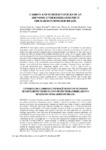Please use this identifier to cite or link to this item:
http://www.alice.cnptia.embrapa.br/alice/handle/doc/339181| Title: | Carbon and nitrogen stocks of an arenosol under irrigated fruit orchards in semiarid Brazil. |
| Authors: | BERNARDI, A. C. de C.  MACHADO, P. L. O. de A.   MADARI, B. E.   TAVARES, S. R. de L.   CAMPOS, D. V. B. de   CRISOSTOMO, L. de A.   |
| Affiliation: | ALBERTO CARLOS DE CAMPOS BERNARDI, CPPSE; PEDRO LUIZ OLIVEIRA DE A MACHADO, CNPAF; BEATA EMOKE MADARI, CNPAF; SILVIO ROBERTO DE LUCENA TAVARES, CNPS; DAVID VILAS BOAS DE CAMPOS, CNPS; LINDBERGUE ARAUJO CRISOSTOMO, CNPAT. |
| Date Issued: | 2007 |
| Citation: | Scientia Agricola, Piracicaba, v. 64, n. 2, p. 169-175, mar./abr. 2007. |
| Description: | Soil organic matter accumulation provides benefits to soil productivity and reduces atmospheric carbon concentration. However, little is known about the accumulation of C and N by sandy soils under perennial irrigated crops in semiarid regions. The objective of this study was to evaluate the effect of irrigated fruit orchard cultivation on the stocks of soil organic carbon (SOC) and total nitrogen (N) of an Arenosol/Quartzpsament from Paraipaba-CE, Semiarid Brazil. Soil samples were taken from irrigated orchards of banana (Musa ssp.), cashew (Anacardium ocidentale), guava (Psidium guajava), bullock's heart (Annona reticulata), mango (Mangifera indica), and sapote (Manilkara zapota) in the wetted-bulb and non-irrigated area between the plant rows. Additional samples were collected from adjacent areas under secondary Caatinga forest, and under a 2-year-old deforested area. Sampling depths were: 0-0.1, 0.1-0.2, and 0.2-0.4 m. The highest contents of SOC and N were found in the surface layer. The soil bulk density did not change in depth. The stocks of SOC and total N under secondary forest at 0-0.40 m layer were 27.6 and 2.4 Mg ha-1, respectively. Caatinga Forest conversion into fruit orchard cultivation led to a decrease of 5 to 23% and 4 to 21% on SOC and N stocks, respectively. Compared to other soil uses, sapote and bullock's heart contributed for a lower decrease of SOC and N stocks after deforestation. Guava, bullock's heart, mango and sapote contributed for improving the SOC stratification index. O acúmulo de matéria orgânica beneficia a produtividade do solo e reduz a concentração do carbono atmosférico. Entretanto, pouco é sabido a respeito do acúmulo de C e N em solos arenosos cultivados com culturas perenes irrigadas em regiões semi-áridas. O objetivo deste trabalho foi avaliar o efeito do cultivo de fruteiras irrigadas nos estoques de C e N de um Neossolo Quartzarênico em Paraipaba, CE. Foram coletadas amostras na linha e na entrelinha de pomares irrigados de banana, caju, manga, sapoti, goiaba e graviola. Em áreas adjacentes sob vegetação de Caatinga hipoxerófila e após dois anos de desmatamento foram coletadas amostras adicionais. As profundidades de amostragem foram: 0 a 0.1, 0.1 a 0.2 e 0.2 a 0.4 m. Os teores de C e N no solo foram mais altos na camada superficial (0 a 0.1 m). Não houve efeito da profundidade de amostragem sobre a densidade do solo. Os estoques de C e N na área com vegetação de Caatinga na camada de 0 a 0.4 m foram de 27,6 and 2,4 Mg ha-1, respectivamente. A retirada da vegetação natural e o cultivo das fruteiras levaram a reduções de 5 a 23% e 4 a 21% nos estoques de C e N do solo, respectivamente. As culturas do sapoti e da graviola contribuíram para o aumento dos estoques de C e N após a retirada da vegetação natural. As culturas da goiaba, graviola, manga e sapoti contribuíram para a melhoria do índice de estratificação deste solo. |
| Thesagro: | Caatinga |
| Keywords: | Matéria orgânica do solo Índice de estratificação do solo |
| DOI: | https://doi.org/10.1590/S0103-90162007000200010 |
| Type of Material: | Artigo de periódico |
| Access: | openAccess |
| Appears in Collections: | Artigo em periódico indexado (CNPS)  |
Files in This Item:
| File | Description | Size | Format | |
|---|---|---|---|---|
| a10v64n2.pdf | 152,66 kB | Adobe PDF |  View/Open |









